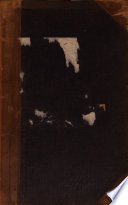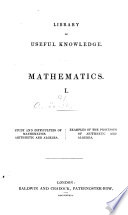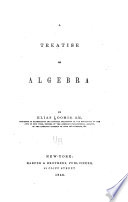 | Augustus De Morgan - 1831 - 108 pages
...exponent of c. Thus c>xc3 = c7. To divide a term of the second series by one which comes before it, subtract the exponent of the divisor from the exponent of the dividend, and make this difference the exponent of c. Thus, c1 -> = <?' c4 These rules are intelligible for all... | |
 | Frederick Emerson - Arithmetic - 1834 - 300 pages
...power; as 23 X 23 X 23 = 29. Division being the reverse of multiplication, it is evident, that if we subtract the exponent of the divisor from the exponent of the dividend, the remainder is the exponent of the quotient. For example, if we divide the fifth power by the third... | |
 | Mathematics - 1836 - 352 pages
...exponent of c. Thus c4xc3 = c7. To divide a term of the second series by one which comes before it, subtract the exponent of the divisor from the exponent of the dividend, and make this difference the exponent of c. Thus26 These rules are intelligible for all terms of the... | |
 | Frederick Emerson - Arithmetic - 1839 - 300 pages
...power; as 23 X 23 X 23 = 29. Division being the reverse of multiplication, it is evident, that if we subtract the exponent of the divisor from the exponent of the dividend, the remainder is the exponent of the quotient. For example, if we divide the fifth power by the third... | |
 | Ebenezer Bailey - Algebra - 1840 - 270 pages
...we are required to divide a power of any letter, as a5, by another power of the same letter, as a3, we must subtract the exponent of the divisor from the exponent of the dividend, and the remainder icill be the exponent of the quotient. 2. Divide a6 by a3. ANs. a3. 3. Divide a3... | |
 | John H. Harney - Algebra - 1840 - 298 pages
...quotient of a2 by a? a4 by tfi? ai6 by aV2? In order to obtain the quotient of one power of a by another, subtract the exponent of the divisor from the exponent of the dividend. The remainder is the exponent of a in the quotient. 3. Divide a4 by a Лпз. a». 4. a8 by a2 5. aз... | |
 | Elias Loomis - Algebra - 1846 - 380 pages
...1 (169.) We have seen in Art. 67, that in order to divide quantities expressed by the same letter, we must subtract the exponent of the divisor from the exponent of the dividend. The same principle may be extended to fractional exponents. Thus let it be required to divide ifl by... | |
 | Elias Loomis - Algebra - 1846 - 376 pages
...; (169.) We have seen in Art. 67, that in order to divide quantities expressed by the same letter, we must subtract the exponent of the divisor from the exponent of the dividend. The same principle may be extended to fractional exponents. Thus let it be required to divide a^ by... | |
 | Charles William Hackley - Algebra - 1846 - 542 pages
...general RULE FOR EXPONENTS IN DIVISION. In order to divide quantities expressed ly the same letter, subtract the exponent of the divisor from the exponent of the dividend, whatever may be the nature of the exponents. This is the same rule as that established in (Art. 17)... | |
 | Thomas Tate (mathematical master.) - 1847 - 138 pages
...to divide a5 by a2. Here we have, g!=axaxaxaxa=qxaxa=a\ In this a? ax a case it will be seen that we subtract the exponent of the divisor from the exponent of the dividend to obtain the exponent of the quotient. Thus, we have generally, -=a«-"' ..... (1) a" v ' Let m—n in... | |
| |